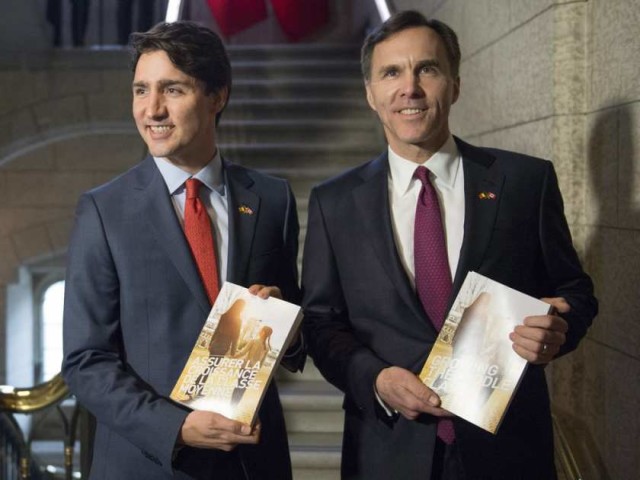Trudeau’s Fiscal Incoherence
If you’ve followed the Canadian economy for the past few years and find yourself confused over Prime Minister Justin Trudeau’s stance on deficits, you’re not alone. The $30 billion dollar deficit in the Liberal government’s first budget represents the latest shift in fiscal policy from Trudeau and the Liberals.
To recap, during the global economic downturn in 2008, the Liberal Party called for immediate deficits and stimulus spending, over the objections of the Conservative Government. They rejected the 2008 Fiscal Update on the basis it did not include stimulus spending. The Liberals, including new MP Justin Trudeau, wanted deficits and stimulus so strongly they signed a letter to the Governor General indicating they were ready to form a coalition government propped up by the separatist Bloc Quebecois in order to do so.
Of course, this overlooks the fact that the 2008 Fiscal Update also planned to phase out the per-vote subsidy, upon which the opposition parties depended heavily, but we’ll take Trudeau and the Liberals at their word. Now, whatever your thoughts on coalition governments, the economic principle was there: Canada needed stimulus spending.
Having had their hand forced, the Conservatives introduced stimulus in the form of temporary infrastructure spending, which would not result in a permanent deficit. The Liberals then spent the following years criticizing the government for running those same deficits they had demanded. Although they had their way in fiscal policy, it seems they were disappointed in not having their way back to government.
Throughout the first half of 2015, new Liberal leader Justin Trudeau continued criticizing the Stephen Harper Government for its deficits. As late as July 2015, he said “It is Conservatives who run deficits, Liberals balance budgets. That’s what history has shown.” Except that history has shown he wanted the Conservatives to run deficits after 2008. But I digress.
After the campaign began, Trudeau pledged a “modest deficit” of $10 billion, and a promise to return to a balanced budget by 2019. Meaning a total of $30 billion would be added to the national debt over 4 years. Of course, that pledge went out the window after forming government, and $30 billion in debt is being added this year alone.
So to recap Trudeau’s positions:
- In 2008-09: Canada needed stimulus spending and accompanying deficits.
- From 2010-early 2015: These deficits are wasteful and the Liberals would balance budgets in government with a fully costed spending plan
- During the 2015 election campaign: The Liberals will run modest deficits of $10B for three years
- The 2016 Budget: The Liberals run a $30B deficit to grow the economy and may not balance the books by 2019 after all.
When faced with criticism from on the size of their deficit, new Treasury Board President Scott Brison called the Harper government one of “the most wasteful governments in Canadian history” because it had added $150 billion to the national debt. Once again, it is a case of the Liberals moving the goalposts. With the Liberals now having a large deficit of their own, the Conservative fiscal policy is bad not because of the deficits they ran, but because they added $150 billion to the national debt over ten years. This is the most recent indicator of fiscal incompetence, says the Liberal government.
Except that it isn’t wholly true – the national debt increased only by about $130 billion over ten years. And the Liberals should be careful what they wish for – recent analysis by TD Economics suggests the Liberals campaign promises and their spending are on pace to add on $150 billion – that very amount they decry right now – over just five years. The Liberals have used another yardstick of economic activity in promising that the debt-to-GDP ratio will decrease, but the same TD analysis suggests precisely the opposite.
Yes, conservatives wanting smaller government will not be happy. But even if you’re a Keynesian, Trudeau’s fiscal policy is a cause for concern. Keynesians believe that government should step up and provide stimulus spending to get the economy going during recessions. But Canada isn’t in a recession right now like it was in 2008-09. Our economy is growing – just not as fast as Trudeau would like. The flip side to Keynesian economics is the government has to step back during the good times, and pay down the debt incurred from the stimulus spending. That time of growth is now.
Further, it’s incredibly difficult to garner any sense of consistency from Trudeau’s changing positions. In less than a year, from April 2015 to March 2016, Trudeau has gone from promising a balanced budget and critiquing Harper’s deficits, to campaigning on a small deficit, to now delivering a large $30 billion deficit. If Trudeau thinks the government needs to go into deficit and fund infrastructure to bolster the economy, then why was he against Harper doing just that from 2009-15 when the economic outlook was far worse?
Justin Trudeau, elected on a platform of Sunny Ways and Real Change, now faces his first major challenge. Economics 101 teaches us that the fundamental problem is choice: having limited resources to satisfy unlimited needs. Trudeau campaigned successfully on both – limiting deficits while increasing spending commitments. It’s one thing to say it while in opposition. To act on it and deliver while in Government is another story. Meeting expectations on both ends of the fiscal spectrum promises to be Trudeau’s biggest challenge yet. There are storm clouds gathering on the Sunny Ways horizon, and very little change to spare.


